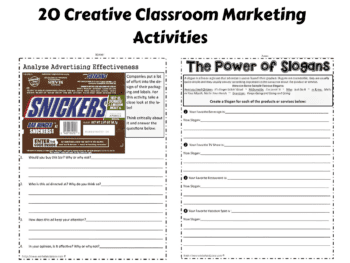Marketing often gets a bad rap as being boring, abstract, or reserved for business professionals. However, with creative activities tailored to their interests, high school students can discover marketing’s practical applications and how it impacts their everyday lives.
The right activities make marketing come alive They empower students to apply concepts, think critically, solve problems, get hands-on, and have fun with peers This boosts engagement, retention, skills growth, and interest in business and marketing careers.
Here are 11 dynamic marketing activities perfect for high school students
1. Sell Advertisement Placements in the Yearbook
Task students with selling ad space in the school yearbook to local businesses. They must identify potential advertisers, craft persuasive pitches, design creative ads, set prices, and close deals. This teaches marketing, sales, negotiation, and design skills.
2. Design a Logo
Split students into teams and have each develop a logo for a new school club, team, or fictional business. They must consider brand messaging, visual appeal, and applicability across mediums. Hold a critiquing session to provide feedback and vote on the top logos.
3. Start an Imaginary Business
Have students ideate, name, brand, create logos for, and develop full business plans for their own imaginary product or service business. Encourage creativity as they outline marketing, operations, finances, and growth plans.
4. Organize Fundraisers
Support a cause by having students groups plan and execute a fundraiser event. They can pick the cause, set fundraising goal, choose the event format, obtain supplies and permits, market the event, manage logistics day-of, collect funds, and optimize future events.
5. Implement a Marketing Campaign
Guide students in developing a complete marketing campaign for a new school initiative like sustainability, a reading challenge, or anti-bullying. They can create posters, videos, announcements, social media posts, bracelets, stickers, competitions, and installations to creatively market the initiative school-wide.
6. Develop and Launch a Product
Have students identify a problem and invent a new product that solves it. They should brainstorm ideas, design prototypes, test with focus groups, incorporate feedback, build buzz, and unveil their new products through pitches or commercials.
7. Build a Website
Students can reinforce online marketing by planning, designing, writing content for, and building websites to promote themselves, a business idea, cause, or school group. Teach HTML, CSS, visual design, search optimization, analytics, and social media integration.
8. Offer an Internship
Offer a hands-on marketing internship. Identify a client like a local business, have students collaborate to develop marketing materials and campaigns, then present to the client. Guide them through strategizing, budgeting, scheduling, dividing responsibilities, executing the plan, and post-event analysis.
9. Analyze Real Ads
Gather print, video, social media, and web ads for brands students know and use. Have them analyze target markets, key messages, influence techniques, and effectiveness. They can even try improving the ads!
10. Examine Viral Campaigns
Have students research successful viral marketing campaigns and unpack elements that drove shares and engagement. Challenge them to use those strategies to brainstorm viral campaigns for given brands or products.
11. Role Play Focus Groups
Assign students brand personas, products, and persuasive scripts. Have rotating groups present, take on consumer roles, ask questions, and provide feedback. This brings focus groups to life so students see their impact on marketing decisions.
Through games, competitions, projects, campaigns, and hands-on creative work, students master marketing fundamentals while having fun, taking ownership, and thinking critically. These activities bring concepts off the pages and into the real world so students view marketing as dynamic, stimulating, and communal.
Facilitating collaborative application boosts soft skills too. Students polish communication, strategic thinking, analysis, creativity, ethics, tech abilities, problem-solving, and teamwork. Combining hard and soft skills gives a well-rounded experience that builds adaptable, employable students prepared for business, marketing, and beyond.
While activities require planning and class time, the payoff is immense. Investing in thoughtful learning experiences yields engaged, motivated learners who eagerly apply themselves. Activities also provide alternative assessments to gauge student progress beyond traditional quizzes and tests.
Maximize impact by linking activities to curriculum, current examples, students’ lives, and follow-up discussions. Schedule presentations to give students an audience. Foster friendly competition between groups. Capture learnings through individual or group write-ups.
With a culture of experiential learning, students form passionate, creative marketing teams ready to strategize and innovate. Activities make school fun and relevant while equipping learners with knowledge and skills for the future. Use these activities to inspire your high schoolers today!
Frequency of Entities:
marketing: 24
students: 20
activities: 10
school: 7
business: 5
product: 4
campaigns: 4
brands: 3
skills: 3
teams: 3

Get the Free eBook: First name
We don’t spam! And you can unsubscribe at anytime.
Teaching Marketing to High School Students
Whether you’re teaching a structured business or commerce course, or simply incorporating marketing concepts into your usual syllabus, then variety, student engagement and interest, along with valuable learning outcomes are usually key goals.
Add the additional challenges of unique learning styles, peer pressure and influence, lifestyle and technology distractions, and the usual – do I need to know this for the exam? – then we sometimes have a complex teaching path to navigate.
But there is a teaching upside when it comes to teaching marketing – and that’s all your high school students being experienced consumers. They have all been shopping, bought and used many products, seen ads, engaged with social media, know and prefer brands, and are quite savvy about the better products for them. This is a great starting point.
Marketing strategies for education business
FAQ
How do you teach marketing in a fun way?
What are the 4 P’s of marketing?
What are market activities with examples?